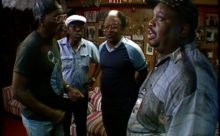Teaching Guide with excerpt, Music District
The Music District
Filmmaker Susan Levitas Copyright Date 1996.
Distributor California Newsreel.
Excerpt Running Time 9 minutes
Overview
This excerpt of a documentary on African American traditional music in Washington, DC, introduces the Junk Yard Band, a Go-Go group who explain and perform a pop music genre popular among African American youth in DC. National Endowment for the Arts National Heritage Fellow Chuck Brown is known as the "godfather of Go-Go" because his DC band developed a heavy rhythm style of funk with one song blending into the next to keep people on the dance floor. As Go-Go bands took off in DC clubs in the 1980s and 1990s, young people started break dancing contests. They call out neighborhood and street names in call-and-response with the band. In the film, teens also use symbols that they flash to the band and the crowd.
For General Objectives, Adaptation Strategies, Standards, and Procedures.
Topics
Teen culture, Go-Go, African American popular music and dance, call and response, improvisation, syncopation, urban life, neighborhoods
Use one of these quotations to spark discussion.
A lot of people don't understand go-go music, 'cuz they might hear it on the tape and they don't know what it's about. But, once you come to the performance, then that's where all the energy comes. It's a call-and-response. The whole show involves the crowd. . . .They wanna say, "Oh, say my name. Say my name. Put me on display." People love to, you know, be known, you see. Let the crowd know they in the house, you know. "I'm over here."
The future starts here with us. Like...how we carry ourselves when we go to the show... you just have to show them that it's not all about violence, that, you know, if you have the talent or the ability to do anything that you should try to go further on with it, instead of, you know, letting the streets hold you back. Because it's not the streets that's holding you back; it's yourself. And we're trying to project that and show them that, that people can come together and do things together without violence
Suggested Activities
1. What are the popular music styles and dances that students enjoy? Where do they hear live music? Where do they dance? After discussion, assign students to interview family and community members about music and dance styles of their youth. If possible, they can collect songs and learn dance for classroom demonstrations. Interview forms and worksheets in Unit VI of www.louisianavoices.org will be useful.
2. Go-Go fans depend on posters and word of mouth to learn about performances. How do students find out about concerts and dances? Ask students to design posters for their favorite music. They must use classroom-appropriate language and images!
3. All pop music is rooted in traditional music, from country to salsa, indie to rap. Have students research African American popular music genres such as blues, jazz, doo-wop, rhythm and blues, soul, funk, hip-hop, rap, and Go-Go. Ask them to relate genres to historical eras and changing race relations in oral or written reports. Class presentations should include music samples. How do students think various kinds of popular music today express contemporary social events and mores?
4. Young African Americans in Washington, DC, play on improvised instruments on the street, collecting and carting around plastic buckets of all sizes, like street musician Rapper D in the film. Where do musicians play in your community? Have students collect buckets, cans, and other found objects to create their own junkyard band. Working in teams, students can assemble instruments, work out rhythms and words, perform, and advertise a classroom performance.
Extensions
Use supplementary contextual materials on Folkstreams.net such as the film transcript, discography, and bibliography.
Resources
Publications
Lornell, Kip, and Charles C. Stephenson, Jr. The Beat: Go-Go's Fusion of Funk and Hip-Hop. Watson-Guptill, 2001.
Web Sites
American Routes www.americanroutes.org archives of public radio program hosted by Nick Spitzer include many interviews with African American musicians.
Louisiana Voices www.louisianavoices.org Unit VI features resources for documenting local music and dance traditions.
